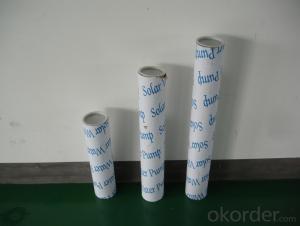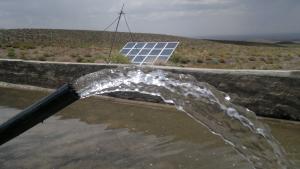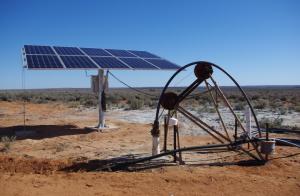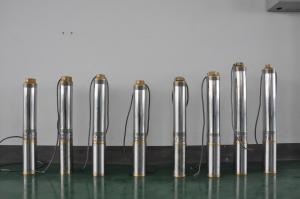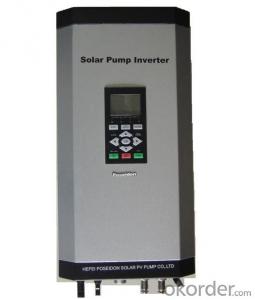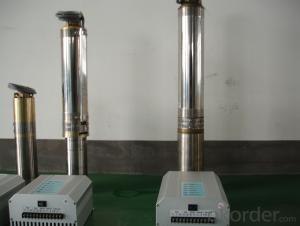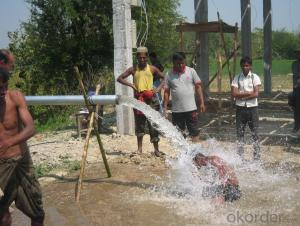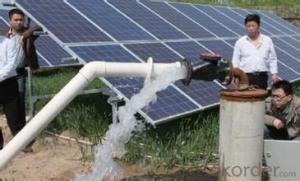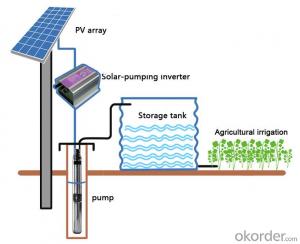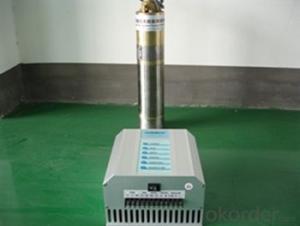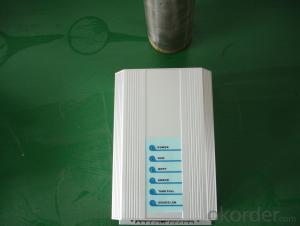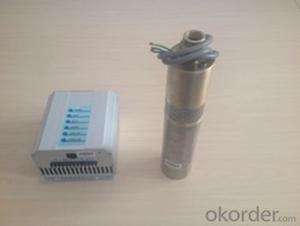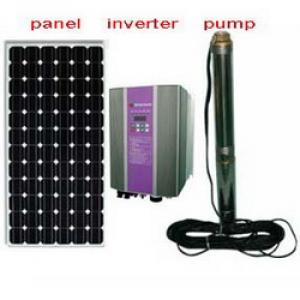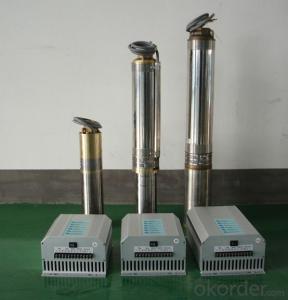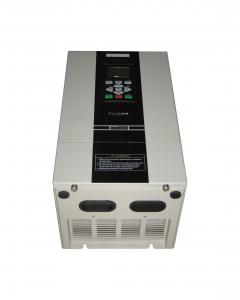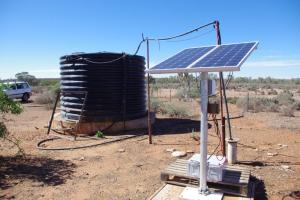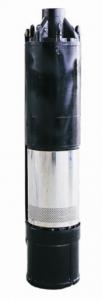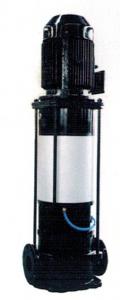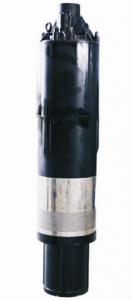DC Solar Water Pump for A Fountain
- Loading Port:
- China Main Port
- Payment Terms:
- TT OR LC
- Min Order Qty:
- -
- Supply Capability:
- -
OKorder Service Pledge
OKorder Financial Service
You Might Also Like
Item Description :
This superb new addition to our solar fountain range comes with a 10w solar panel,and a powerful fountain pump that is capable of producing fountains of up to 2m in height. As well as being easy to set up and use.Instruction manual is supplied for assembly and maintenance.
Solar Fountain Key Features :
Powered by direct sunlight
No high voltage electric mains required
Safe for children
Max. height of fountain: 2M
Max. flow capacity: 800 L/H(176 GAL)
10W Polycrystalline solar panel included
18V DC brushless pump
Solar Pump Features :
Can produce fountains up to : 2M (tube height) 1.4M (fountain height)
Comes with multiple nozzle accessories
Cable Length : 5M
Solar Panel Features :
10W peak power.
Polycrystalline highly efficient solar panel
Comes mounted in aluminium frame
Comes with ground stake and rotating knob so you can angle your panel toward the sun
What You Will Get :
10W solar panel
Solar pump
Ground Sake
Nozzle accessories
Precautions :
DO NOT alter or change the product itself or its components
Operate pump in freshwater only, never above 50 degrees celsius
Keep away from flammable liquids
Do not connect to any other power supply other than the included
- Q: How long does it take for a solar pump to pay for itself in terms of energy savings?
- The payback period for a solar pump varies depending on factors such as the initial cost, energy savings, and local conditions. Generally, it takes around 2 to 5 years for a solar pump to pay for itself through energy savings.
- Q: Can a solar pump be used for water supply in aquaculture farms?
- Yes, a solar pump can be used for water supply in aquaculture farms. Solar pumps are an environmental-friendly and cost-effective solution for aquaculture farms as they utilize the sun's energy to power the pump. They can be used to circulate and aerate water in fish ponds, provide water for fish tanks, or transfer water between different parts of the farm. Solar pumps can help reduce reliance on grid electricity and minimize operational costs while ensuring a consistent and sustainable water supply for aquaculture activities.
- Q: What is the expected noise level of a solar pump during installation?
- The expected noise level of a solar pump during installation can vary depending on the specific model and its design. Generally, solar pumps are known for their silent operation as they do not rely on traditional mechanical components like motors or engines. Instead, they use solar energy to power the pump, which results in a quieter operation compared to conventional pumps. During installation, the noise level is typically minimal as it primarily involves the mounting and connection of the solar panels, pump, and other necessary components. However, some noise may be generated during this process due to tools or equipment used for installation. It is important to note that the noise level during installation is temporary and typically subsides once the solar pump is fully installed and operational. Additionally, the noise level during operation is usually very low or almost negligible, making solar pumps an ideal choice for environments where noise pollution is a concern, such as residential areas or farms in close proximity to living spaces. Overall, the expected noise level of a solar pump during installation is typically low, and once installed, the pump operates silently, contributing to a quieter and more peaceful environment.
- Q: What is the expected lifespan of the inverter used in a solar pump system?
- The lifespan of an inverter used in a solar pump system can vary depending on various factors. Typically, a well-maintained and high-quality inverter can last for 10 to 20 years. There are several factors that can influence the lifespan of an inverter. The quality of the inverter itself is crucial. Opting for a reputable brand and a high-quality inverter can significantly increase its longevity. Additionally, the type of inverter, such as string inverters or microinverters, can also impact its expected lifespan. The environmental conditions in which the inverter operates also play a role in its longevity. Extreme temperatures, excessive humidity, or direct sunlight exposure can accelerate wear and tear on the inverter components, potentially reducing its lifespan. Therefore, it is important to install the inverter in a well-ventilated and shaded area to minimize environmental stress. Regular maintenance and proper care can also extend the lifespan of an inverter. It is important to keep the inverter clean, check for any loose connections, and conduct routine inspections to identify and address potential issues early on, preventing further damage. Lastly, the load and usage patterns of the solar pump system can impact the inverter's lifespan. If the system consistently operates at high loads or experiences frequent fluctuations, it may strain the inverter, potentially shortening its lifespan. In conclusion, while the expected lifespan of an inverter used in a solar pump system can vary, selecting a high-quality inverter, maintaining it properly, and ensuring optimal operating conditions can help maximize its longevity.
- Q: Can a solar pump be used in areas with limited access to water desalination systems?
- Yes, a solar pump can be used in areas with limited access to water desalination systems. Solar pumps are an efficient and sustainable solution for accessing water from various sources such as rivers, lakes, wells, or even the ocean. While they do not directly desalinate water, solar pumps can be used to extract water from saline sources, and then alternative methods like solar stills or other desalination systems can be employed to treat the water and make it suitable for consumption or irrigation.
- Q: Can a solar pump be used for water supply in remote islands or coastal areas?
- Water supply in remote islands or coastal areas can be facilitated by the use of solar pumps. These pumps harness solar energy to operate, eliminating the necessity for electrical grid connections or fuel-powered generators. As a result, solar pumps are an ideal solution for regions with limited or unreliable electricity, like remote islands or coastal areas. Solar pumps can effectively extract water from a variety of sources, including wells, boreholes, rivers, or lakes. This ensures a dependable and sustainable water supply. In coastal areas where there might be a high water table or brackish water, solar pumps can be specifically designed to handle these conditions, making them particularly advantageous. Additionally, solar pumps are environmentally friendly and require minimal maintenance. They do not emit greenhouse gases or contribute to air or noise pollution, making them an environmentally sustainable and clean option for water supply in remote or environmentally sensitive areas. In conclusion, solar pumps present a cost-effective and dependable alternative for water supply in remote islands or coastal regions. By utilizing solar power, they provide access to clean water without relying on traditional energy sources.
- Q: Can solar pumps be used for water supply in military bases or camps?
- Yes, solar pumps can be used for water supply in military bases or camps. Solar pumps operate using solar energy, making them a sustainable and cost-effective solution for water supply in remote locations. They can be easily installed and provide a reliable source of water for various applications such as drinking, sanitation, and irrigation. Additionally, solar pumps are quiet, require minimal maintenance, and can withstand harsh environmental conditions, making them suitable for military operations.
- Q: How does the angle of incidence of sunlight affect the performance of a solar pump?
- The performance of a solar pump is greatly affected by the angle at which sunlight strikes the solar panels. The angle of incidence refers to the angle at which sunlight hits the surface of the panels. When sunlight hits the panels directly, perpendicular to their surface, it allows for the maximum conversion of solar energy into electricity. This leads to the best performance of the solar pump, as the panels are able to generate the highest amount of power. On the other hand, when sunlight strikes the panels at a shallow or oblique angle, the amount of solar energy absorbed and converted into electricity decreases. This results in a decrease in the overall efficiency and performance of the solar pump. The angle of incidence is influenced by several factors, including the time of day, season, and geographical location. To ensure optimal performance, it is crucial to position the solar panels correctly in order to maximize the angle of incidence. This can be achieved by tilting the panels towards the sun or using tracking systems that adjust the position of the panels to follow the sun's movement throughout the day. Moreover, if the angle of incidence remains consistently low due to factors like shading from nearby structures or vegetation, it can have a significant impact on the performance of the solar pump. In such cases, it may be necessary to make changes to the installation location or remove any obstructions to optimize the angle of incidence and enhance the efficiency of the pump. In summary, the angle at which sunlight strikes the solar panels is crucial for the performance of a solar pump. It is important to position the panels correctly to maximize the angle of incidence and achieve optimal efficiency, ensuring that the pump operates at its highest potential.
- Q: Can solar pumps be used for water supply in remote research stations or observatories?
- Yes, solar pumps can be used for water supply in remote research stations or observatories. Solar pumps are an ideal solution for remote locations as they are not dependent on grid electricity and can operate using solar energy. They provide a sustainable and reliable source of water supply, making them suitable for remote areas where access to electricity may be limited. Additionally, solar pumps require minimal maintenance and have a long lifespan, making them a cost-effective and efficient option for water supply in remote research stations or observatories.
- Q: How does the size of the water pipe affect the performance of a solar pump?
- The performance of a solar pump is greatly influenced by the size of the water pipe. The pipe's size determines the flow rate and pressure that the pump can generate, which in turn affects its efficiency and effectiveness. When the pipe diameter is smaller, it restricts the water flow, resulting in lower flow rates and decreased pump performance. This can lead to insufficient water delivery, slower filling of tanks or reservoirs, and longer pumping durations. Additionally, the reduced flow rate can create backpressure on the pump, increasing its workload and potentially impacting its lifespan. On the contrary, a larger pipe diameter enables higher flow rates, leading to improved pump performance and faster water delivery. This means that the pump can fill tanks or reservoirs more rapidly and operate with greater efficiency. Furthermore, a larger pipe diameter reduces the backpressure on the pump, contributing to an extended lifespan and reduced maintenance expenses. It is important to consider that while a larger pipe diameter generally enhances pump performance, there is still an optimal pipe size to be taken into account. If the pipe is excessively large, it can result in excessive friction losses and increased energy consumption, offsetting the advantages of the larger diameter. Therefore, it is crucial to select the appropriate pipe size that matches the pump's specifications and the required water flow in order to achieve optimal performance. In conclusion, the size of the water pipe has a significant impact on the performance of a solar pump. Choosing the correct pipe diameter ensures efficient water flow, faster delivery, reduced backpressure, and ultimately maximizes the pump's effectiveness and longevity.
Send your message to us
DC Solar Water Pump for A Fountain
- Loading Port:
- China Main Port
- Payment Terms:
- TT OR LC
- Min Order Qty:
- -
- Supply Capability:
- -
OKorder Service Pledge
OKorder Financial Service
Similar products
Hot products
Hot Searches
Related keywords
